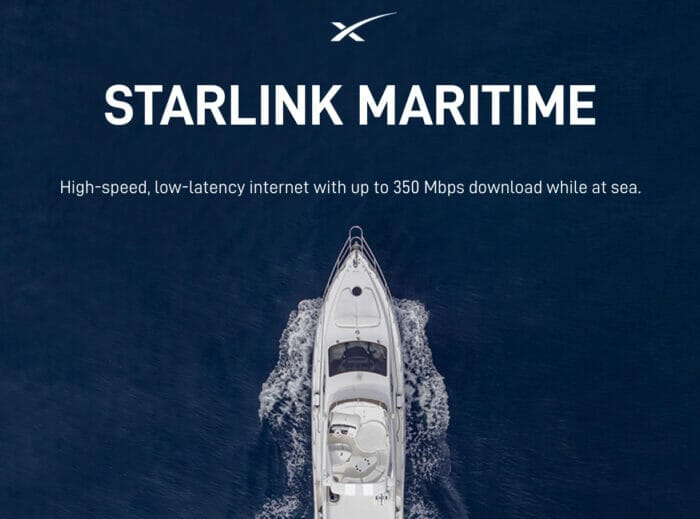
Starlink are going to provide a solution for moving vessels, but before we get too excited check out the price! Think US$10,000 for the unit and US$7000/month for service!
Looks like I will be right that Iridium will the solution for most of us for some time to come. In 2019 I predicted 10 years more of standard old Iridium for most of us.
Might still be right, but then again five years from now might be closer for always-on internet at sea at a reasonable price—only 30 years after the billionaires started promising it for “next year”.

Interesting essay on “Loose Cannon” about Starlink in the Bahamas. Apparently people are installing the non-mobile Starlink antennas on their boats and getting pretty good reception at many anchorages throughout the Bahamas. For now anyway.
https://loosecannon.substack.com/p/bahamas-are-paradise-for-starlink?utm_source=substack&utm_medium=email
Hi John,
A well thought out and researched piece on Starlink, thanks for the link.
We have starlink on our boat currently. We’re only really using it at anchor or at the dock. Far far better than the crappy wifi at the marina or cellular at anchor. Presumably, it works for at least 12 miles offshore. Iridium Go is fine for us when offshore.
Hi Bill,
Sounds like a good combo. I’m not even sure I would want always on high speed internet at sea!
“Maritime” does not equal “marine”. Clearly the maritime option is aimed at commercial vessels (i.e. maritime). Still hoping they come out with a marine version but for now the RV version is working really well.
There are rumours that Tesla is working on a mobile phone (Tesla Model Pi) which would be Starlink capable.
This might be more useful (and affordable) for the average cruiser.
So release date as yet, though from what I could find this could be as early as late 2022 or as late as 2030.
You never really can tell with Musk/Tesla.
Hi Wim,
Interesting, but I wonder how that would work given that it seems like Starlink needs a dish, albeit a small one. Matt did a good piece on how Starlink works here: https://www.morganscloud.com/2019/10/15/new-satellite-communications-systems/
The point being that packing an antenna into a phone capable of sending and receiving at Starlink data rates will be exponentially harder than doing the same at Iridium data rates. That said, Musk and team have surprised us before. We shall see.
Hi John,
Thanks for the link.
I’m well aware how Starlink works – I’ve got it installed at home. I live in deepest Brittany and whilst I wait (and wait and wait…) for fibre to reach my home, Starlink is the only decent broadband option available to me.
Before I installed dishy at a home, I temporarily installed it on the boat. Purely on a trail basis as terminals were still geolocked at that time.
I sail singlehanded 95% of the time, so my boat probably differs (greatly) from your average family blue water cruising boat. (I sail an older 36′ IOR One-Tonner).
This is what I found:
If the Tesla Model Pi is indeed Starlink capable, I do hope it will come with a hotspot feature.
ATB
Hi Wim,
Thanks for the first hand report, always the best information. Your point about power draw is particularly useful to know, as I had not thought of that.
I have a Starlink (RV version) on the boat since the end of July.
In my experience it doesn’t work “offshore”; the coverage I’ve seen tracks the map at https://www.starlink.com/map pretty much exactly. But it does work in remote anchorages, which lets me work remotely from the boat (which was the goal), and it does work in coastal waters, even in significant seas.
Wim’s right about the power draw, it is significant. I’ve had to upgrade my solar panels, and I think the delay before I did so might’ve damaged my house battery. To quantify, it takes about 4A at 12V constantly, so almost 100Ah / day. That’s more than my fridge. One mitigation strategy I’ve used is just to shut it down during the night (I’m sleeping anyway) or when I’m away.
Performance is amazing; I don’t bother with marina wifi anymore. I hope they eventually come up with a better plan for cruisers who want “offshore” coverage, as it has the potential to be a game-changer for safety at sea.
Hi Emile,
Thanks for the real world report and for quantifying the power use, very useful.
Ours uses about 20 watts quiescent, 50-70 watts warm-weather active, 100 watts cold-weather active. (It heats itself up to melt snow on cold days.) Definitely not something you want to run from batteries 24/7 unless you really are swimming in excess power.
Downtime, if unobstructed, is on the order of 10 seconds per day. Available bandwidth is hugely variable but I don’t think I’ve seen it fall below approx. 10/2 Mbps (typical is more like 100-200/10-15) and latency rarely goes over 200 ms (typical is closer to 50 ms).
I have been hearing lots of promising reports about using Starlink RV in coastal waters, but I would like to ask Emile and Bill (and anyone else using it on a boat) how they have installed the square dish, and whether they leave it out in the weather 24/7, or whether they take it below when not in use (not clear how weatherized it is). Thanks, Tim